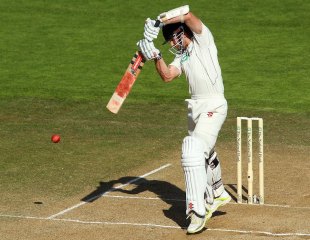New Zealand v South Africa, 2011-12
At Wellington (Basin Reserve), March 23-27, 2012. Drawn. Toss: New Zealand.

|
|||
|
Related Links
Tour and tournament reports : New Zealand v South Africa, 2011-12
Series/Tournaments:
South Africa tour of New Zealand
Teams:
New Zealand
| South Africa
|
|||
Near-apocalyptic weather in advance led even locals to predict a washout. In the event, the teams played the equivalent of four days - but New Zealand, and particularly Williamson, deserved considerable credit for batting out the final 81 overs for an honourable draw.
Petersen put a miserable two Tests behind him with a solid century and, if he had scored more rapidly, South Africa might even have won. But sodden conditions, grey skies and half a dozen breaks for rain - not to mention his own predicament - made life tricky. In the circumstances, his batting was solidity itself. Meanwhile, Amla suffered a horrendous blow when he edged a ball from Martin into his groin on 33; he was barely able to stagger from the field when, 30 runs later, he finally top-edged a hook. He was taken straight to hospital for emergency surgery on his scrotum.
Duminy seized his late chance after Kallis woke with a stiff neck. He made a century of sublime cover-drives interspersed with much less convincing hooks and pulls, and even those were admirable for his determination to tackle a reputed weakness against the short ball. Gillespie collected four late wickets to finish with burnished figures of six for 113, but they were well deserved, given his stamina and a painful cut on his left big toe. South Africa batted until after tea on the third day, and conventional wisdom suggested the match was doomed to be drawn. Still, there were more than 200 overs to play.
Flynn and Guptill reached 65 by the close with little bother, confirming the view that the contest would meander towards forgettability. But Philander and Steyn worked their way ruthlessly through the batting on day four - in spite of a pitch that was apparently improving rather than deteriorating - and Morkel broke Taylor's left arm; his next game would be as Morkel's team-mate with Delhi Daredevils three weeks later, though he missed the first three IPL matches. Inflicting the follow-on was South Africa's best chance, but at 263 for five - in effect, six - New Zealand required just a dozen runs and the draw seemed more certain than ever. Then three wickets fell at the same score. Gillespie was left with the task of adding 12 in the unlikely company of Martin, who managed to contribute a couple before Gillespie completed the job with consecutive fours, one nicked over first slip's head, the next inside-edged to fine leg.
Philander's extraordinary start to Test cricket had brought his 50th wicket - Bracewell - in his seventh match, the joint-second-fastest ever, behind Charlie Turner's six Tests in the 1880s. Among modern players, only Turner's fellow Australians Terry Alderman and Rodney Hogg had come close, with eight Tests apiece.
Smith and Petersen reached 75 at five an over by the close, and on the final morning the rate was upped to more than six thanks to de Villiers, who Twenty20'd his way to 68 from 49 deliveries, and Duminy. Smith delayed the declaration longer than anyone had predicted, until the lead was 388. The South Africans may have been keen to win 2-0, but not enough to allow New Zealand the tiniest scent of victory. "I didn't think they deserved any more," he said afterwards. "They batted conservatively and used up a lot of time. They didn't make much attempt to force the pace and win the game. I wasn't going to give them a chance."
As it happened, 81 overs should have been more than enough for South Africa to win. But a catch by Petersen at cover off Steyn was controversially denied by TV umpire Billy Doctrove to give Williamson his first life, on seven. He had another, on 22, courtesy of a rare error by de Villiers at second slip. But Williamson made the most of his luck to compile a second Test century, which was good enough even for Smith to note that it could be "career-defining". His fortitude was immense: he withstood relentless verbal intimidation from most of the fielders, while the fast bowlers seemed more interested in attracting the attention of the resident ambulance driver than the umpire.
Morkel, given the new ball by Smith on a hunch, responded with his best spell of the series. Bowling a fuller length than usual, he accounted for McCullum, Brownlie and Vettori with classic yorkers, and went on to become the first South African to claim the first six wickets in a Test innings since Ernie Vogler at Lord's in 1907. When Boucher caught Flynn, it was the 999th catch or stumping he had completed in international cricket (998 as wicketkeeper); but a freak eye injury at Taunton in July, on the first day of the tour of England, would force his retirement - and deprive him of 1,000.
South Africa's final chance was blown with ten overs to go when de Villiers dropped another catch, Bracewell on eight off de Lange. At seven down, with Taylor absent and only Gillespie and Martin to come, it would have been hard to deny the tourists, despite Williamson's obduracy.
Man of the Match: M. Morkel.
Close of play: first day, South Africa 136-2 (Petersen 44, Duminy 23); second day, South Africa 246-2 (Petersen 96, Duminy 76); third day, New Zealand 65-0 (Flynn 35, Guptill 28); fourth day, South Africa 75-0 (Petersen 38, Smith 34).

